Next week, the ECB is likely to cut interest rates by 25 basis points, despite recent weaker inflation data and stronger negotiated wage growth. At this point, it will be difficult for European policymakers to back away from their declaration of easing monetary conditions at the June meeting. However, last week’s publications may influence the pace and scale of the further rate cut cycle.
The first reduction in the cost of money in the eurozone is almost a foregone conclusion. This is indicated by market pricing and recent statements from ECB Governing Council members, even those in the “hawk” camp. However, the market will not receive further guidance on how the entire cycle will proceed. We will likely hear the familiar statement that future decisions will depend on incoming data. In this way, the ECB does not want to commit to a specific path for rates.
The “dove” camp will have difficulty pushing for another cut as early as July. The inflation rate in the eurozone has not fallen for two months. In May, it even increased from 2.4% to 2.6%, and the core index halted its downward trend and rose from 2.7% to 2.9%. Adding to this the stronger negotiated wage growth in the first quarter (4.7%), there are increasing arguments that the ECB will likely want to wait a bit longer with the next cut. A cautious approach has recently been expressed by some “dovish” representatives (Pablo Hernández de Cos and Luis de Guindos).
Comments and interviews from recent weeks suggest that most ECB Governing Council members favor a “gradual” approach. As a result, interest rate decisions will likely be made quarterly and during meetings with new projections. Some Council members, such as Belgium’s Pierre Wunsch and France’s François Villeroy de Galhau, have suggested that ECB experts’ forecasts should once again have more weight alongside hard data.
Another indication that the ECB will proceed slowly and with particular caution is the statement by Philip Lane, the ECB’s chief economist. Lane stated that the goal for 2024 is not to normalize monetary policy but merely to reduce its degree of restrictiveness.
Over the past few months, the market has changed its stance not only on the Fed but also on the ECB’s future actions. While in January, futures contracts priced in six rate cuts this year and saw the deposit rate at 2% by mid-2025, the market now expects less than three full cuts in 2024 and sees the deposit rate at around 2.75% by the end of 2025.
This change has been influenced by macroeconomic developments. Economic data has improved noticeably. In the first quarter, the economy performed better than forecasted, with growth at 0.3%. PMI for the manufacturing sector began to rebound from very low levels, and services continue to do well. The disinflation process has stalled, and prices have started to rise again. Meanwhile, wages are expected to increase by over 4% on average in 2024, which will drive wage inflation.
I do not expect the upcoming ECB decision to have a strong impact on the euro’s exchange rate against the dollar. The rate cut is already fully priced in. Lagarde’s response to the recent data and the new macro projections will be important. The market will have plenty to interpret. If policymakers highlight inflation and wage risks, this could be perceived as a slightly “hawkish” tone, potentially boosting the euro.
Łukasz Zembik, Oanda TMS Brokers
